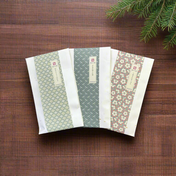The shincha season has started. In the western part of Kanagawa Prefecture, where I live, tea picking takes place from late April through May. This marks the beginning of the busiest season for tea farmers.

Shincha(新茶) refers to the first flush of tea leaves harvested in a given year. The rich sunlight and warmth of spring encourage the growth of tea leaves, resulting in a tea that is fresh, fragrant, and full of flavor.
Read more about Shincha : What is shincha and why is it so special?
In this article, I’d like to share a recipe that lets you fully enjoy shincha without any waste : onigiri made with tea leaves.

What is Onigiri?
Onigiri (also called omusubi) is a traditional Japanese dish made with rice. Its history dates back to the Yayoi period (around the 3rd century BCE), when rice cultivation first spread across Japan. Even today, onigiri remains a staple in lunchboxes across the country, coming with a wide range of flavors and fillings.
In this recipe, we’ll use leftover shincha leaves from brewing tea. Even after brewing, tea leaves still remain both flavor and nutrients. Instead of discarding them, why not transform them into a delicious onigiri? The tender leaves of the first flush are perfect for eating and truly bring out the essence of the season.

Ingredients
- 2 cups (400ml) short-grain or sushi rice
- 2 cups (400ml) water
- Salt, as needed
- 10g (from 2 steeping) leftover shincha leaves
- 5g(1tbsp) sesame seeds
Preparation
- Cook the rice.
Use your preferred method or follow this How to Cook Japanese Rice in a Pan
- Prepare the tea leaves.
After steeping your shincha, remove the used tea leaves from the teapot, drain them and chop them finely.
Instructions
- While the rice is still warm, mix in the chopped tea leaves and sesame seeds.
- Wet your hands with water and sprinkle salt on your hands to prevent the rice from sticking.
- Take a scoop of rice in one hand, cover it with your other hand and gently shape it into a ball.
- Lightly press the rice into a triangular shape, rotating it a few times as you shape it. Sprinkle additional sesame seeds on top, if desired.


Filling Options
For extra flavor, try finely scrambled egg or diced cheese. Just add in the rice when you mix in the shincha leaves.

Savor the fresh, delicate flavor of this simple, rice ball recipe. Let's celebrate the Shincha season!
Today's Recommendations
Natural Salt : Amabito no Moshio Gourmet Seaweed Salt with Gift Bag by Kamagari Bussan
I recommend using sea salt for onigiri. This particular salt contains seaweed, which enhances the umami flavor of the rice ball.
Shincha 2025 - Japanese First Flush Spring Green Tea : Check it from here
Enjoy the vibrant taste of spring in every bite and sip!
Shincha Articles
What is shincha and why is it so special?
Celebrate Hachijyu-Hachiya (88th Night)


